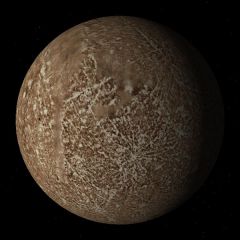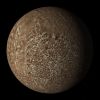Difference between revisions of "Mercury"
(Created add-on table.) |
(Added table items.) |
||
| (11 intermediate revisions by the same user not shown) | |||
| Line 4: | Line 4: | ||
|colspan="2" align="center"|[[Image:MercuryScrshot.jpg|240px]] | |colspan="2" align="center"|[[Image:MercuryScrshot.jpg|240px]] | ||
|- | |- | ||
| − | |colspan="2" align="center"|'''Mercury in Orbiter''' | + | |colspan="2" align="center"|'''Mercury in Orbiter 2016 with D3D9''' |
|- | |- | ||
!bgcolor="lightsteelblue" colspan="2"|Designation | !bgcolor="lightsteelblue" colspan="2"|Designation | ||
| Line 99: | Line 99: | ||
CAUTION! It is to be noted by pilots flying close to the ground at Mercury when approaching the North and South poles. If the vessel crosses either pole at low altitude and any great speed, errors in the simulator causes the scenario to freeze and may cause Crash to Desktop. However, if the pole is approached at very low speed, perhaps one or a few meters per second, the vessel can pass over and even land at the pole. | CAUTION! It is to be noted by pilots flying close to the ground at Mercury when approaching the North and South poles. If the vessel crosses either pole at low altitude and any great speed, errors in the simulator causes the scenario to freeze and may cause Crash to Desktop. However, if the pole is approached at very low speed, perhaps one or a few meters per second, the vessel can pass over and even land at the pole. | ||
| − | The landing and docking lights on the DeltaGlider do no light up the terrain, but will another object such as a ship. | + | The landing and docking lights on the DeltaGlider do no light up the terrain, but will light up another object such as a ship. |
| − | |||
| − | |||
===== Topography and Textures ===== | ===== Topography and Textures ===== | ||
Table of Orbiter versions and add-ons which include Mercury as a body. | Table of Orbiter versions and add-ons which include Mercury as a body. | ||
{|class="wikitable sortable” style="text-align: center" | {|class="wikitable sortable” style="text-align: center" | ||
| + | |- | ||
| + | |colspan="8"|<center>Orbiter versions and add-ons which include Mercury</center> | ||
|- | |- | ||
!Add-on!!Source!!Version!!Author!!Type!!Release Date!!Compatibility!!Wiki article | !Add-on!!Source!!Version!!Author!!Type!!Release Date!!Compatibility!!Wiki article | ||
| Line 117: | Line 117: | ||
|[http://orbit.medphys.ucl.ac.uk/download.html Orbiter core package download]<br>(The actual download page for Orbiter 2016)||Orbiter download page||Orbiter 2016||martins||Orbiter download||23 August 2016||Orbiter 2016|| | |[http://orbit.medphys.ucl.ac.uk/download.html Orbiter core package download]<br>(The actual download page for Orbiter 2016)||Orbiter download page||Orbiter 2016||martins||Orbiter download||23 August 2016||Orbiter 2016|| | ||
|- | |- | ||
| − | |[https://www.orbiter-forum.com/resources/celestial-bodies-motion-part-1-4-v2-0-0.132/ Celestial Bodies Motion - Part 1/4 - v2.0.0]||O-F Resources||v2.0.0||cristiapi||Scenery||2 July 2015|||| | + | |[https://www.orbiter-forum.com/resources/celestial-bodies-motion-part-1-4-v2-0-0.132/ Celestial Bodies Motion - Part 1/4 - v2.0.0]||O-F Resources||v2.0.0||cristiapi||Scenery||2 July 2015||*module only|| |
|- | |- | ||
|[https://www.orbiter-forum.com/resources/orbiter-2010-p1.5428/ Orbiter 2010-P1]||O-F Resources||100830||martins||Orbiter Download||30 August 2010||Orbiter 2010-P1|| | |[https://www.orbiter-forum.com/resources/orbiter-2010-p1.5428/ Orbiter 2010-P1]||O-F Resources||100830||martins||Orbiter Download||30 August 2010||Orbiter 2010-P1|| | ||
| Line 131: | Line 131: | ||
|[https://www.orbiter-forum.com/resources/orbiter-2003-p2.5433/ Orbiter 2003-P2]||O-F Resources||031217||martins||Orbiter Download||17 December 2003||Orbiter 2003-P2|| | |[https://www.orbiter-forum.com/resources/orbiter-2003-p2.5433/ Orbiter 2003-P2]||O-F Resources||031217||martins||Orbiter Download||17 December 2003||Orbiter 2003-P2|| | ||
|- | |- | ||
| − | |[https://www.orbiter-forum.com/resources/orbiter- | + | |[https://www.orbiter-forum.com/resources/orbiter-2003-p1.5434/ Orbiter 2003-P1]||O-F Resources||031105||martins||Orbiter Download||5 November 2003||Orbiter 2003-P1| |
|- | |- | ||
|[https://www.orbiter-forum.com/resources/orbiter-2002.5436/ Orbiter 2002]||O-F Resources||020419||martins||Orbiter Download||19 April 2002||Orbiter 2002|| | |[https://www.orbiter-forum.com/resources/orbiter-2002.5436/ Orbiter 2002]||O-F Resources||020419||martins||Orbiter Download||19 April 2002||Orbiter 2002|| | ||
| Line 168: | Line 168: | ||
*[[w:Mariner 10|Mariner 10 mission]] at Wikipedia | *[[w:Mariner 10|Mariner 10 mission]] at Wikipedia | ||
*[[w:MESSENGER|MESSENGER mission]] at Wikipedia | *[[w:MESSENGER|MESSENGER mission]] at Wikipedia | ||
| + | |||
| + | <gallery widths="100" heights="100"> | ||
| + | MercuryOrbiter2001.jpg|<center>Mercury in Orbiter 2001</center> | ||
| + | MercuryOrbiter2002.jpg|<center>Mercury in Orbiter 2002</center> | ||
| + | Mercury-orbiter2002p3.jpg|<center>Mercury in Orbiter 2002P3</center> | ||
| + | Mercury-Orbiter2003P2.jpg|<center>Mercury in Orbiter 2003P2</center> | ||
| + | Mercury-Orbiter2005P1.jpg|<center>Mercury in Orbiter 2005P1</center> | ||
| + | Mercury-Orbiter2006P1.jpg|<center>Mercury in Orbiter 2006P1</center> | ||
| + | Mercury-Orbiter2010P1-Orbiter2010P1.jpg|<center>Mercury in Orbiter 2010P1</center> | ||
| + | MercuryScrshot.jpg|<center>Mercury in Orbiter 2016 with D3D9</center> | ||
| + | Mercury in true color.jpg|<center>Mercury as seen by [[w:MESSENGER|MESSENGER]] | ||
| + | </gallery> | ||
== References == | == References == | ||
<references/> | <references/> | ||
| − | |||
[[Category:Celestial bodies]] | [[Category:Celestial bodies]] | ||
| − | |||
{{SolarSystem}} | {{SolarSystem}} | ||
{{Planet-Stub}} | {{Planet-Stub}} | ||
| − | [[Category: Articles]] | + | [[Category:Articles]] |
| + | [[Category:Celestial bodies]] | ||
[[Category:Solar System]] | [[Category:Solar System]] | ||
[[Category: Planets]] | [[Category: Planets]] | ||
Latest revision as of 03:12, 12 November 2024
Mercury is the smallest planet in the solar system and is the closest to the sun. Mercury is a rocky planet appearing much like the moon and has virtually no atmosphere (none is modeled in Orbiter), and has no natural satellites. Mercury has been a part of Orbiter since the earliest version in 2001.
Mercury was visited in 1974 and 1975 by Mariner 10 in two flybys and was again visited by MESSENGER spacecraft orbiting Mercury from 2011 to 2015 when it was deorbited. BepiColombo, a joint mission by the European Space Ageny (ESA) and Japan Aerospace Exploraation Agency (JAXA) was launched on 20 October 2018 and is scheduled to reach Mercury on 5 December 2025.
Orbital characteristics[edit]
Mercury is the innermost planet in the system with a semimajor axis of 5.79×107 km. But, the orbital eccentricity is the largest of all the planets, about 0.2056, its distance ranging from 46 million to almost 70 million km from the Sun, and the inclination of its orbit is just over 7°, also largest of all the planets. In Orbiter 2001, Mercury's orbit was defined by the Mercury.cfg file, from Orbiter 2002 on, its orbit has been defined by the Vsop87.dll file.
Physical characteristics[edit]
Mercury's mean radius is 2440 km, smaller than Ganymede and Titan, but more massive at a bit more than 3.3×1023 kg.[1] Mercury is unique in the solar system in that it is tidally locked with the Sun in a 3:2 spin-orbit resonance; it rotates three times for each two orbits around the Sun, which means that one day on Mercury is two of its years.[1] It also has the smallest axial tilt with respect to its orbit, about 2 arcminutes.
Geological features[edit]
In Orbiter 2016, Mercury is modeled as a sphere with no elevations, but visually, it has a texture and approximately 300 named features on Mercury have been included in the stock Orbiter 2016, albedo features as well as craters, ridges, plains, escarpments, valleys, and one mountain.
See Geology of Mercury for list of features.
Notice to pilots[edit]
CAUTION! It is to be noted by pilots flying close to the ground at Mercury when approaching the North and South poles. If the vessel crosses either pole at low altitude and any great speed, errors in the simulator causes the scenario to freeze and may cause Crash to Desktop. However, if the pole is approached at very low speed, perhaps one or a few meters per second, the vessel can pass over and even land at the pole.
The landing and docking lights on the DeltaGlider do no light up the terrain, but will light up another object such as a ship.
Topography and Textures[edit]
Table of Orbiter versions and add-ons which include Mercury as a body.
| Add-on | Source | Version | Author | Type | Release Date | Compatibility | Wiki article |
|---|---|---|---|---|---|---|---|
| Orbiter 2016 - torrent files | O-F Resources | 2016 | martins | Orbiter Download | 23 August 2016 | Orbiter 2016 | |
| Orbiter 2016 Core - MSI / EXE edition | O-F Resources | 2016 | martins | Orbiter Download | 23 August 2016 | Orbiter 2016 | |
| Orbiter 2016 Core - ZIP edition | O-F Resources | 2016 | martins | Orbiter download | 23 August 2016 | Orbiter 2016 | |
| Orbiter core package download (The actual download page for Orbiter 2016) |
Orbiter download page | Orbiter 2016 | martins | Orbiter download | 23 August 2016 | Orbiter 2016 | |
| Celestial Bodies Motion - Part 1/4 - v2.0.0 | O-F Resources | v2.0.0 | cristiapi | Scenery | 2 July 2015 | *module only | |
| Orbiter 2010-P1 | O-F Resources | 100830 | martins | Orbiter Download | 30 August 2010 | Orbiter 2010-P1 | |
| Orbiter 2010 | O-F Resources | 100606 | martins | Orbiter Download | 5 June 2010 | Orbiter 2010 | |
| Orbiter 2006-P1 | O-F Resources | 060929 | martins | Orbiter Download | 29 September 2006 | Orbiter 2006-P1 | |
| Orbiter 2006 | O-F Resources | 060504 | martins | Orbiter Download | 4 May 2006 | Orbiter 2006 | |
| 2005 (with P1 patch files) | O-F Resources | 050216 | martins | Orbiter Download | 16 February 2005 | Orbiter 2005 | |
| Orbiter 2003-P2 | O-F Resources | 031217 | martins | Orbiter Download | 17 December 2003 | Orbiter 2003-P2 | |
| Orbiter 2003-P1 | O-F Resources | 031105 | martins | Orbiter Download | 5 November 2003 | ||
| Orbiter 2002 | O-F Resources | 020419 | martins | Orbiter Download | 19 April 2002 | Orbiter 2002 | |
| Orbiter 2001 | O-F Resources | 010503 | martins | Orbiter Download | 3 May 2001 | Orbiter 2001 | |
- Planet Mercury Level 8 High Resolution Surface released 19 October 2004 by BigJimW providing level 8 textures for Mercury.
- Mercury level 8 textures released 23 January 2012 by Felipi1205, provides level 8 texture for Mercury.
- Mercury heightmap + Level 9 global textures, released 23 April 2013 by 4throck, provides level 9 topogrraphy and textures for Mercury.
- Mercury Level 11 released 30 September 2013 by Post much? provides level 11 for Mercury.
- Mercury surface and heightmap tiles for Orbiter 2016, released 1 December 2016 by asbjos, provides level 7 topography and level 8 surface features for the planet. A new Mercury.cfg will load the 3D terrain, however, the existing mercury.cfg should be backed up before installation.
Mariner 10[edit]
Historically the first probe to use gravitational assists and first probe to visit Mercury. It made three fly-by's of Mercury between November 1973 and March 1974, but did not enter orbit.
- GEP - Mariner 10 to Orbiter 2010, released 29 May 2011 by Felipi125.
- GEP - Mariner 10 released 19 June 2004 by missleman01.
MESSENGER[edit]
Historically the first probe to enter orbit around Mercury. After three fly-by's between January 2008 and September 2009, it entered an highly elliptical orbit around Mercury on March 18th, 2011.
- Messenger released 26 JUne 2006 by unknown author.
- MESSENGER MOI released 14 March 2011 by NukekET.
- GEP-Messenger released 7 March 2012 by TheXFiles19.
External links[edit]
- Mercury at Wikipedia
- Mariner 10 mission at Wikipedia
- MESSENGER mission at Wikipedia
Mercury as seen by MESSENGER
References[edit]
| edit The Solar System | |
|---|---|
| Central star |
Sun (Sol) |
| Planets |
Mercury - Venus - Earth - Mars - Jupiter - Saturn - Uranus - Neptune |
| Natural satellites |
Moon - Phobos - Deimos - Io - Europa - Ganymede - Titan - more... |
| Add-ons |
Planets - Dwarf Planets - Small objects - Natural satellites - Alternative star systems |
 | This article, about a planet, is a stub. You can help Orbiterwiki by expanding it. |









